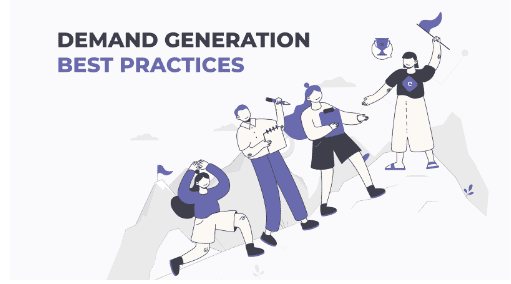Table of Contents
Toggle
How to Master Demand Generation Best Practices and Drive Business Growth?
Demand generation creates potential customers’ awareness and interest in your product or service. It’s a crucial part of any marketing strategy as it helps drive business growth. To master demand generation best practices, you must focus on three key areas: audience targeting, content creation, and lead nurturing.
The first step is to identify your target audience. This involves understanding who your ideal customers are, their pain points, and where they spend their time online. Once you have this information, you can create targeted content that speaks directly to their needs and interests.
The second step is to create high-quality content that resonates with your target audience. This can include blog posts, whitepapers, case studies, videos, and social media posts. The key is to provide valuable information that helps solve their problems and positions your business as a thought leader in your industry.
The third step is to nurture leads through the sales funnel. This involves creating a series of touchpoints that help move potential customers closer to making a purchase. This can include email marketing campaigns, webinars, and personalized outreach.
To drive business growth, continually monitoring and analyzing your demand generation efforts is essential. This includes tracking key metrics such as website traffic, lead conversion rates, and customer acquisition costs.
By constantly refining your strategy and tactics, you can optimize your demand generation efforts and drive sustainable business growth over the long term.
Demand Generation and its Role in business growth
Demand generation is a marketing strategy that aims to create interest and awareness in a company’s products or services among potential customers. Demand generation seeks to generate high-quality leads and move them through the sales funnel, leading to increased revenue and business growth.
Demand generation involves a variety of tactics, such as content marketing, social media, email marketing, search engine optimization, and events. By creating valuable and engaging content that speaks directly to potential customers’ needs and pain points, businesses can establish themselves as thought leaders and build trust with their audience.
The role of demand generation in business growth must be balanced. Businesses can increase their customer base and revenue by creating a steady stream of high-quality leads. Additionally, demand generation can help companies identify new growth opportunities by uncovering new market segments or customer needs.
Effective demand generation requires a deep understanding of the target audience, a well-planned strategy, and the ability to measure and analyze results. By continuously refining their approach based on data-driven insights, businesses can optimize their demand generation efforts and drive sustainable growth over the long term.
Fundamental Principles and Strategies for effective demand generation
Effective demand generation requires a strategic approach that focuses on creating interest and awareness in a company’s products or services among potential customers. To achieve success, businesses should follow these fundamental principles and strategies:
- Identify your target audience: Understanding your ideal customer is crucial for effective demand generation. You need to identify their pain points, needs, and preferences to create targeted campaigns that resonate with them.
- Create high-quality content: High-quality content is the foundation of effective demand generation. Your content should provide value and be tailored to the needs and interests of your target audience. This includes blog posts, case studies, videos, and social media posts.
- Leverage multiple channels: Effective demand generation requires a multi-channel approach. You should leverage a mix of tracks, such as social media, email marketing, content marketing, paid advertising, and events, to reach your target audience.
- Optimize your website: Your website is critical to your demand generation efforts. Ensure your website is optimized for search engines, easy to navigate, and has clear calls to action.
- Nurture leads: Once you have generated leads, you must nurture them through the sales funnel. This includes email marketing campaigns, personalized outreach, and targeted content to keep them engaged and move them closer to purchasing.
- Analyze and measure results: To optimize your demand generation efforts, you need to analyze and measure your results. This includes tracking key metrics such as website traffic, lead conversion rates, and customer acquisition costs.
Following these fundamental principles and strategies, businesses can create effective demand-generation campaigns that drive revenue growth and business success.

Best Practices for Demand Generation
Demand generation is a critical part of any successful marketing strategy, and there are several best practices that businesses should follow to achieve success:
- Define your target audience: Understanding your ideal customer is crucial for effective demand generation. You need to identify their pain points, needs, and preferences to create targeted campaigns that resonate with them.
- Create high-quality content: High-quality content is the foundation of effective demand generation. You should create a variety of content formats, such as blog posts, case studies, videos, and social media posts, that provide value and are tailored to the needs and interests of your target audience.
- Leverage multiple channels: Effective demand generation requires a multi-channel approach. You should leverage channels such as social media, email marketing, content marketing, paid advertising, and events to reach your target audience.
- Optimize your website: Your website is critical to your demand generation efforts. Ensure your website is optimized for search engines, easy to navigate, and has clear calls to action.
- Use marketing automation: Marketing automation can help streamline your demand generation efforts and improve your lead nurturing process. You can use tools such as email marketing automation, lead scoring, and drip campaigns to automate your marketing processes.
- Measure and analyze results: To optimize your demand generation efforts, you must measure your results. This includes tracking key metrics such as website traffic, lead conversion rates, and customer acquisition costs.
By following these best practices, businesses can create effective demand-generation campaigns that drive revenue growth and business success.
Building a comprehensive demand generation strategy
Building a comprehensive demand generation strategy requires a holistic approach considering your target audience’s needs and preferences. Here are the critical steps involved in creating a comprehensive demand-generation plan:
- Identify your target audience: The first step is identifying your ideal customer and creating buyer personas representing your target audience. This involves understanding their pain points, needs, and preferences.
- Develop a content strategy: Based on your buyer personas, you should create a content strategy that includes a mix of formats such as blog posts, case studies, videos, and social media posts. Your content should provide value and be tailored to the needs and interests of your target audience.
- Leverage multiple channels: To reach your target audience, you should leverage social media, email marketing, content marketing, paid advertising, and events. You should tailor your approach to each channel based on the preferences of your target audience.
- Optimize your website: Your website is critical to your demand generation efforts. Ensure your website is optimized for search engines, easy to navigate, and has clear calls to action.
- Use marketing automation: Marketing automation can help streamline your demand generation efforts and improve your lead nurturing process. You can use tools such as email marketing automation, lead scoring, and drip campaigns to automate your marketing processes.
- Measure and analyze results: To optimize your demand generation efforts, you must explore and measure your results. This includes tracking key metrics such as website traffic, lead conversion rates, and customer acquisition costs. You should use this data to refine your strategy and tactics over time.
Following these steps, businesses can create a comprehensive demand-generation strategy that drives revenue growth and business success. It’s important to remember that demand generation is an ongoing process that requires continuous refinement and optimization.
By staying up-to-date with the latest trends and technologies, you can ensure that your demand-generation efforts are always practical and impactful.
Identifying and targeting your ideal customer personas
Identifying and targeting your ideal customer personas is crucial for effective demand generation. Here are the critical steps involved in the process:
- Conduct market research: The first step is to conduct market research to gain a deeper understanding of your target audience. This involves analyzing industry trends, competitors, and customer data to identify patterns and insights.
- Develop buyer personas: Based on your market research, you should develop buyer personas representing your ideal customers. A buyer persona is a fictional representation of your target customer, including demographic, psychographic, and behavioral information.
- Gather data: To create accurate buyer personas, you should gather data from various sources such as customer surveys, social media analytics, and website analytics. This data should be used to identify common pain points, needs, and preferences among your target audience.
- Define your value proposition: Once you clearly understand your target audience, you should define your value proposition. This statement explains how your product or service solves problems and meets the needs of your target audience.
- Tailor your messaging and content: Based on your buyer personas and value proposition, you should tailor your messaging and content to the needs and preferences of your target audience. This includes creating content that speaks directly to their pain points and interests.
- Use targeted marketing channels: To reach your target audience, you should use targeted marketing channels that align with their preferences. This may include social media advertising, email marketing, and content marketing.
Following these steps, businesses can identify and target their ideal customer personas to create effective demand-generation campaigns. It’s important to remember that buyer personas should be regularly updated and refined based on changing customer needs and industry trends.

Measuring and Optimizing Demand Generation Performance
Measuring and optimizing demand generation performance is crucial for ensuring the success of your marketing efforts. Here are the critical steps involved in the process:
- Define key performance indicators (KPIs): The first step is to define the KPIs that you will use to measure the success of your demand generation efforts. This may include metrics such as website traffic, lead conversion rates, and customer acquisition costs.
- Track and analyze data: Once you have defined your KPIs, you should track and analyze data to measure your performance. This includes using tools such as Google Analytics, CRM software, and marketing automation platforms to gather data on website traffic, lead generation, and customer acquisition.
- Identify areas for improvement: Based on your data analysis, you should identify areas for improvement in your demand generation strategy. This may include optimizing your website, refining your messaging and content, or adjusting your marketing channels.
- Implement changes: Once you have identified areas for improvement, you should implement changes to your demand generation strategy. This may involve redesigning your website, creating new content, or reallocating your marketing budget.
- Test and iterate: After implementing changes, you should test and iterate your demand generation strategy to measure the impact of your changes. This involves continually refining your design based on data-driven insights to improve your performance over time.
By following these steps, businesses can measure and optimize their demand generation performance to drive revenue growth and business success. It’s important to remember that demand generation is an ongoing process that requires continuous refinement and optimization.
By staying up-to-date with the latest trends and technologies, you can ensure that your demand-generation efforts are always practical and impactful.
Final Thoughts
Demand generation is a crucial part of any successful marketing strategy. Creating targeted campaigns that resonate with your ideal customers can generate high-quality leads and drive revenue growth.
The key to effective demand generation is to take a holistic approach that involves identifying your target audience, creating high-quality content, leveraging multiple marketing channels, optimizing your website, using marketing automation, and measuring and analyzing your results.
To create a comprehensive demand generation strategy, businesses must conduct market research, develop buyer personas, gather data, define their value proposition, tailor their messaging and content, and use targeted marketing channels.
Businesses can continually refine their strategy and tactics to improve results by measuring and optimizing demand generation performance.
As technology and consumer preferences evolve, businesses must stay up-to-date with the latest trends and best practices in demand generation. Doing so can ensure their marketing efforts remain effective and impactful in a constantly changing landscape.
FAQs
How long does it typically take to see results from demand generation efforts?
The timeline for seeing results from demand generation efforts can vary depending on various factors, such as the industry, target audience, marketing channels used, and the quality of the content and messaging.
Generally, demand generation efforts may take several months to see significant results.
One reason for this is that demand generation is a process that involves building awareness and interest among potential customers. Developing relationships with potential customers and moving them through the sales funnel takes time.
Additionally, the impact of demand generation efforts can be cumulative, meaning that the longer you invest in demand generation, the more impact you will see over time.
That being said, several factors can impact the timeline for seeing results. For example, if you are targeting a particular niche audience, you may see results more quickly than if you are targeting a broad audience.
Similarly, if you use highly targeted marketing channels and high-quality content, you may see results faster than broad-media channels and generic content.
Ultimately, the timeline for seeing results from demand generation efforts will depend on various factors unique to your business and your target audience. It’s essential to be patient and refine your approach to ensure that your demand-generation efforts are effective and impactful.

How can I ensure my demand generation strategy aligns with my overall business goals?
Aligning your demand generation strategy with your overall business goals ensures that your marketing efforts drive revenue growth and business success. Here are some critical steps you can take to ensure alignment:
- Define your business goals: The first step is to define your overall business goals. This may include destinations such as increasing revenue, expanding your customer base, or launching a new product or service.
- Develop a marketing plan: Based on your business goals, you should develop a marketing plan that outlines your demand generation strategy. Your marketing plan should include a clear understanding of your target audience, your value proposition, your messaging and content strategy, and your marketing channels.
- Align your KPIs with your business goals: Your demand generation KPIs should be aligned with your overall business goals. For example, if your goal is to increase revenue, your KPIs may include lead conversion rates, customer acquisition costs, and average deal size.
- Monitor and analyze results: To ensure alignment with your business goals, you should regularly monitor and analyze your demand generation results. This involves tracking your KPIs, measuring your ROI, and identifying areas for improvement.
- Adjust your strategy as needed: Based on your results analysis, you should adjust your demand generation strategy to ensure alignment with your business goals. This may involve refining your messaging and content process, reallocating your marketing budget, or changing your marketing channels.
By following these steps, you can ensure that your demand generation strategy is aligned with your overall business goals. This alignment will help ensure that your marketing efforts are driving revenue growth and business success over the long term.
What common challenges do businesses face when implementing demand-generation best practices?
Implementing demand-generation best practices can be challenging for businesses, and they may face several common obstacles. Here are some of the most common challenges:
- Lack of resources: Implementing a comprehensive demand generation strategy can require significant time, money, and personnel resources. Small and mid-sized businesses, in particular, may need help allocating the resources required to implement a successful demand generation program.
- Difficulty in identifying and targeting the ideal customer personas: Identifying and targeting the perfect customer personas can be challenging, especially if businesses have a broad or complex target audience. Companies can create effective demand-generation campaigns with a clear understanding of their target audience.
- Creating high-quality content: Creating high-quality content that resonates with your target audience can be difficult, especially if businesses need a deeper understanding of their customer’s pain points and preferences.
- Measuring and analyzing results: Measuring and analyzing the results of demand generation efforts can be complex, especially if businesses need more tools and expertise. This can make optimizing demand generation strategies and making data-driven decisions challenging.
- Adapting to changing market conditions: Market conditions and consumer preferences can change rapidly, making it challenging for businesses to stay up-to-date with the latest demand generation best practices.
To overcome these challenges, businesses should build a solid foundation for their demand generation efforts by conducting thorough market research, developing clear buyer personas, creating high-quality content, leveraging multiple marketing channels, optimizing their website, and measuring and analyzing results. It’s also essential to stay up-to-date with the latest trends and technologies in demand generation and to continually refine and optimize your approach based on data-driven insights.
- Success vs. Significance: Understanding the Difference and Achieving Both - October 1, 2023
- 8 Steps to SaaS Success: From Idea to Business - September 30, 2023
- The Importance of Testing in SaaS: Ensure Quality and Success - September 29, 2023